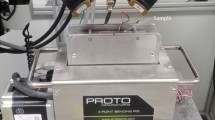Abstract
A methodology for determining Young’s modulus of materials by non-ideally sharp indentation has been developed. According to the principle of the same area-to-depth ratio, a non-ideally pyramidal indenter like a Berkovich one can be approximated by a non-ideally conical indenter with a spherical cap at the tip. By applying dimensional and finite element analysis to the non-ideally conical indentation, a set of approximate one-to-one relationships between the ratio of nominal hardness/reduced Young’s modulus and the ratio of elastic work/total work, which correspond to different tip bluntness, have been revealed. The nominal hardness is defined as the maximum indentation load divided by the cross-section area of the conical indenter specified at the maximum indentation depth. As a consequence, Young’s modulus can be determined from a nanoindentation test only using the maximum indentation load and depth, and the work done during loading and unloading processes. The new method for determining Young’s modulus is referred to as “pure energy method”. The validity of the method was examined by performing indentation tests on five materials. The experimental results and the standard reference values are in good agreement, indicating that the proposed pure energy method is a promising substitution for the most widely used analysis models at present.
Similar content being viewed by others
References
Pethica, J. B., Hutchings, R., Oliver, W. C., Hardness measurement at penetration depth as small as 20mn, Phil. Mag. A, 1983, 48(4): 593–606.
Loubet, J. L., Georges, J. M., Marchesini, O., Meille, G., Vickers indentation curves of magnesium oxide (MgO), J. Tribology, 1984, 106(1): 43–48.
Newey, D., Wilkens, M. A., Pollock, H. M., An ultra-low-load penetration hardness tester, J. Phys. E: Sci. Instrum, 1982, 15(1): 119–122.
Oliver, W. C., Pharr, G. M., An improved technique for determining hardness and elastic modulus using load and displacement sensing indentation experiments, J. Mater. Res., 1992, 7(6): 1564–1583.
Pharr, G. M., Oliver, W. C., Brotzen, F. R., On the generality of the relationship among contact stifffness, contact area, and elastic modulus during indentation, J. Mater. Res., 1992, 7(3): 613–617.
Cheng, Y.-T., Li, Z., Cheng, C.-M., Fundamentals of Nanoindentation and Nanotribology II, (eds. Baker, S. P., Cook, R. F., Corcoran, S. G. et al. in MRS Proc. 649, Warrendale, PA, 2001), Q1.1.
Cheng, Y.-T., Cheng, C.-M., Relationships between hardness, elastic modulus, and the work of indentation, Appl. Phys. Lett., 1998, 73(5): 614–616.
Giannakopoulos, A. E., Suresh, S., Determination of elastoplastic properties by instrumented sharp indentation, Scripta Mater., 1999, 40(10): 1191–1198.
Venkatesh, T. A., Van Vliet, K. J., Giannakopoulos, A. E. et al., Determination of elasto-plastic properties by instrumented sharp indentation: guidelines for property extraction, Scripta Mater., 2000, 42(9): 833–839.
Dao, M., Chollacoop, N., Van Vliet., K. J. et al., Computational modeling of the forward and reverse problems in instrumented sharp indentation, Acta Mater., 2001, 49(19): 3899–3918.
Karlsson & Hibitt, Sorensen Inc. ABAQUS Theory Manual Version 6.2, Pawtucket, 2000.
Author information
Authors and Affiliations
Corresponding author
Rights and permissions
About this article
Cite this article
MA, D., Chung Wo, O., Liu, J. et al. Determination of Young’s modulus by nanoindentation. Sci. China Ser. E-Technol. Sci. 47, 398–408 (2004). https://doi.org/10.1360/03ye0590
Received:
Issue Date:
DOI: https://doi.org/10.1360/03ye0590




